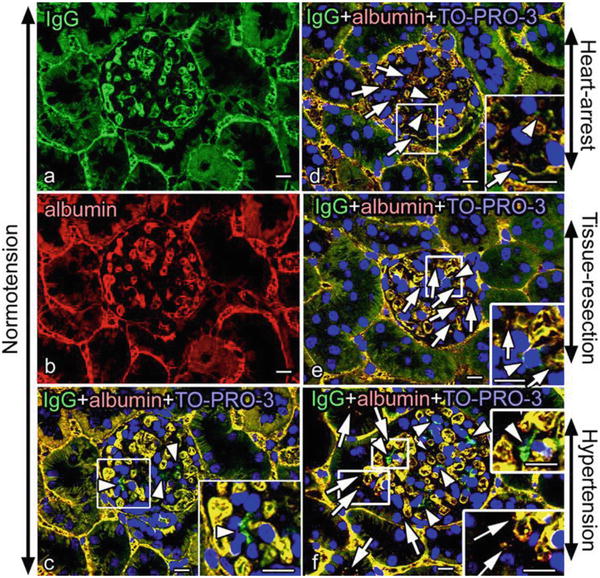Fig. 19.1
Light micrographs of mouse renal cortical tissues prepared under various hemodynamic condition s ; “in vivo cryotechnique ” under normotensive (a, normal), heart-arrest (b, heart-arrest), and acute hypertensive (c, hypertension) conditions and tissue resection followed by quick-freezing (d, tissue resection). The glomerular capillary loop s are kept open under the normotensive condition (a, arrows), but almost collapsed under the heart-arrest condition (b, arrows). They are widely open under the acute hypertensive condition (c, arrows), as compared with those under the normotensive condition. However, they are most severely collapsed in the specimens prepared by tissue resection followed by the quick-freezing (d, arrow). The luminal spaces of proximal (c, P) and distal (c, D) tubules and Bowman’s spaces (c, B) under the acute hypertension condition are more clearly opened, as compared with those under the other hemodynamic condition s (a, b, d). Scale bars 20 μm

Fig. 19.2
Confocal laser scanning micrographs, showing immunolocalizations of IgG with the whole molecular weight (a, IgG, green color) and albumin (b, red color) in the renal glomeruli, obtained by the double immunofluorescence staining. Under the normotensive condition (a–c, normotension), both IgG and albumin immunolocalizations are detected within the glomerular capillary loop s , and only IgG is also immunolocalized in the mesangial areas (MA) (c, arrowheads). Under the heart-arrest condition (d, heart-arrest) and tissue resection followed by the quick-freezing method (e, tissue resection), the immunoreaction products of both IgG and albumin are also found in Bowman’s space (d and e, arrows), and only IgG is slightly immunolocalized in MA (d and e, arrowheads). Under the acute hypertensive condition (f, hypertension), large clumped immunoreaction products of IgG are more clearly seen in MA (f, arrowheads). The rapid translocation of both albumin and IgG is detected in some Bowman’s spaces, and their reabsorption is also detected in the proximal convoluted tubule s (f, arrows). Scale bars 10 μm
19.3 Mechanism of Immunolocalization of Serum Proteins in Glomeruli
The leakage of albumin and kappa light chain into Bowman’s space was increased under the acute hypertensive condition , as also suggested by their reabsorption into the proximal tubule s [5]. Moreover, their immunolocalization changes in the glomeruli were also due to the increased pressures in GCL, easily causing their passage through GBM . Some IgGs with the whole molecular weight were reported to be extensively trapped in the GBM under pathological conditions, such as membranoproliferative glomerulonephritis, membranous nephropathy, and lupus nephritis [20, 21]. In such cases, they may be hardly leaked out into Bowman’s spaces, because of large molecular sizes, conformational change s , and immune complex formation. The leakage of both albumin and IgG from GCL into Bowman’s spaces could be detected under the heart-arrest condition . In addition, their immunolocalization in the conventional specimens prepared by quick-freezing of the resected kidney tissues was almost similar to that observed under the heart-arrest condition.
19.4 Concluding Remarks
The “in vivo cryotechnique ” followed by the freeze-substitution method would be a reliable tool to keep soluble serum protein s in situ and provide transient images of functioning glomeruli in the living mice. In addition, it also allowed us to examine the precise immunodistribution of serum protein s leaked out of the glomeruli and their reabsorption into the renal proximal tubule s under the various hemodynamic condition s . The present figures were already published in our paper, Histochem Cell Biol (2006) 26:399–406, and cited with their permissions.



